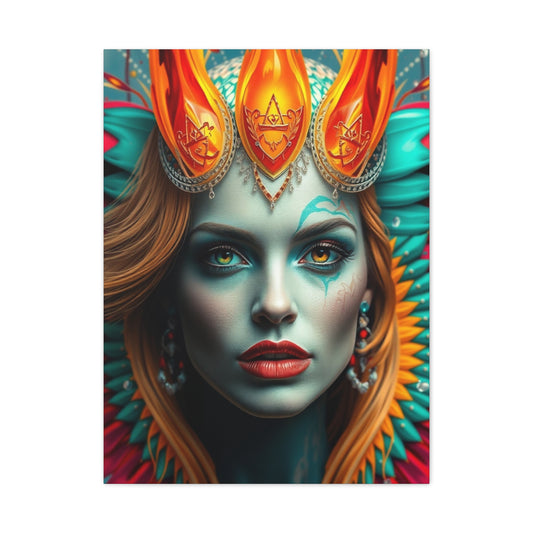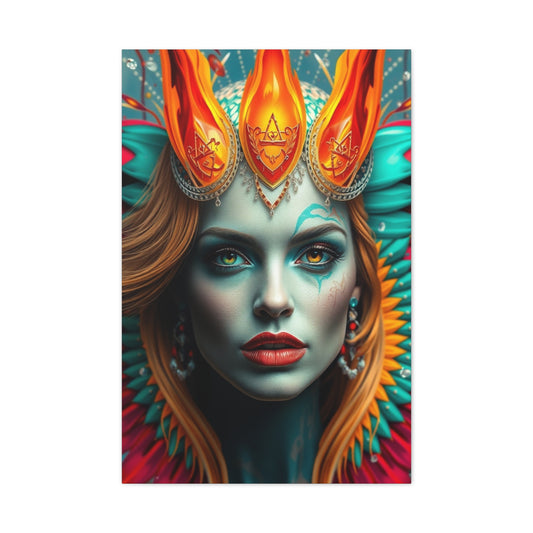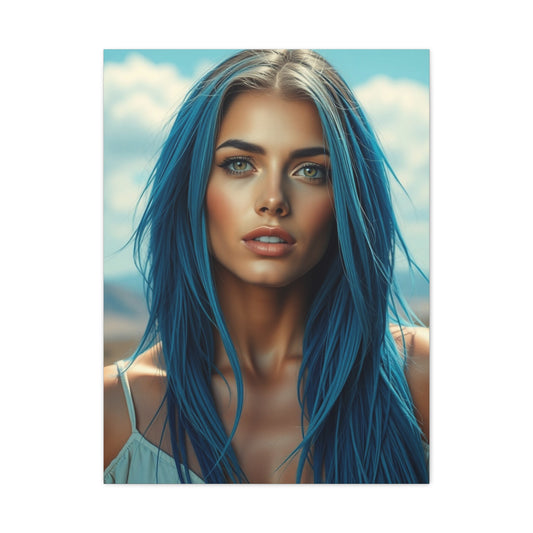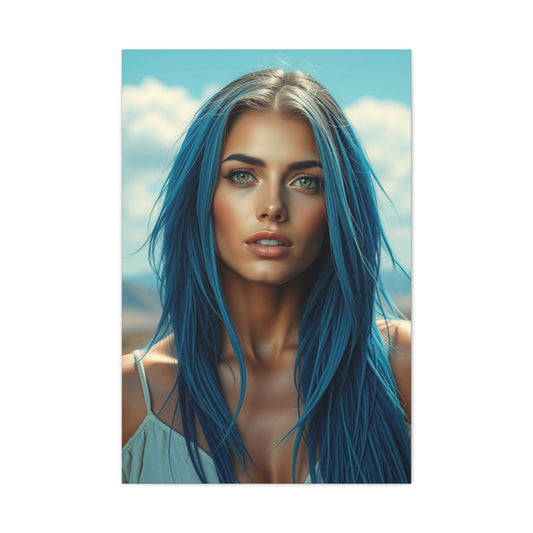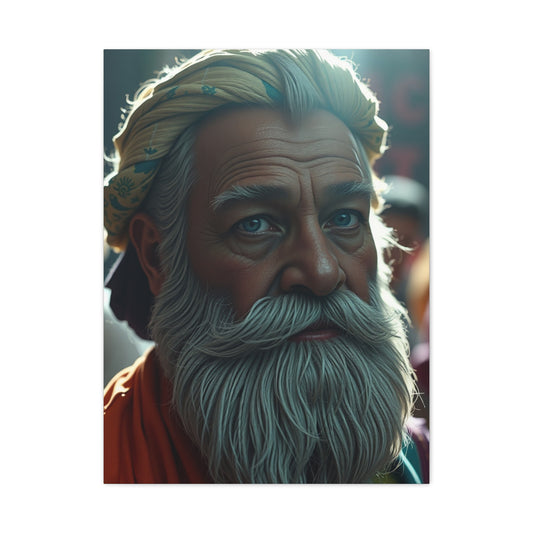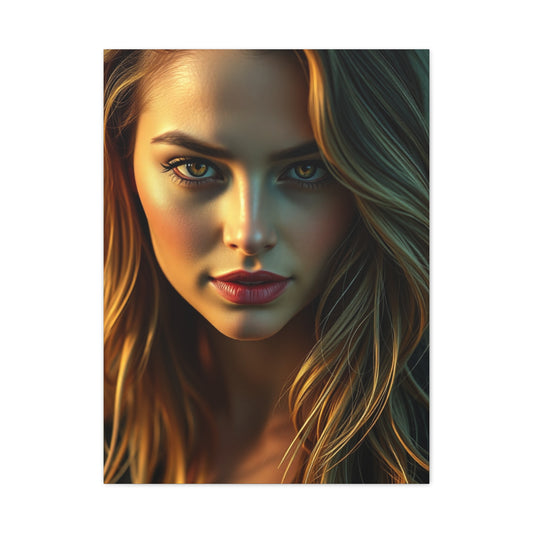Coloring has evolved from a simple childhood hobby into a sophisticated form of personal expression, offering therapeutic benefits for people of all ages. DIY art canvases have become increasingly popular as a way for individuals and families to express creativity and infuse their homes with unique, personalized decor. Whether you’re an experienced artist or a complete beginner, why not create a beautiful piece of artwork that reflects your personal style and enhances your living space? These ready-to-paint canvases provide the perfect medium for this kind of artistic exploration.
Beyond just a fun and relaxing activity, coloring your own canvas allows you to choose a color palette that complements your home’s existing décor. This not only offers a satisfying creative outlet but also provides the opportunity to add a vibrant and personal touch to any room. Let’s explore what makes DIY art canvases such an appealing choice for home decoration and personal enjoyment.
What Are DIY Art Canvases?
DIY art canvases are more than just tools for painting; they represent a creative opportunity for anyone who loves to engage in artistic expression, regardless of skill level. These high-quality white canvases come pre-printed with intricate black ink outlines, offering a perfect starting point for individuals eager to create personalized works of art. Mounted on durable, sturdy frames, these canvases provide a smooth surface designed to enhance the painting experience, making it both enjoyable and accessible to everyone—from beginners to seasoned artists.
What makes DIY art canvases truly special is their versatility. Whether you’re looking for a simple project to pass the time or a more detailed, intricate piece to challenge your skills, there is a design to suit every taste. From basic patterns to elaborate illustrations, these canvases cater to a broad spectrum of artistic preferences. The ability to fill in these outlined designs with your choice of colors transforms them from blank slates into vibrant pieces of art that reflect your creativity and personal style.
A Fun and Relaxing Creative Outlet
In a world where stress is often a part of daily life, DIY art canvases offer a peaceful and therapeutic activity. Coloring, often thought of as a childhood pastime, has become a popular way for adults to relax and unwind. The meditative nature of filling in intricate designs with color helps calm the mind and provides a sense of accomplishment once completed. It allows you to escape from the pressures of the day and immerse yourself in a task that promotes mindfulness and relaxation.
Moreover, DIY art canvases give you the freedom to choose your color palette, ensuring that your completed artwork harmonizes perfectly with the existing décor of your home. This makes them not only an enjoyable activity but also a practical one, as you can create artwork that complements your interior design. Whether your home features minimalist, contemporary, or traditional decor, there is a coloring canvas that will blend seamlessly into your space, bringing your vision to life.
Related Catagories:
DIY Art Canvases for All Ages
Although many might view DIY art canvases as a fun project for children, they have gained significant popularity among adults as well. The simplicity of the design combined with the complexity of coloring allows for a rewarding experience at any skill level. In fact, adult coloring is a trend that has surged in recent years, providing a fulfilling way for individuals to engage in creative activities while producing art that can be proudly displayed in their homes.
For families, these canvases provide an excellent bonding activity. Whether it’s a group project for the entire family or a quiet solo activity, DIY art canvases offer a flexible option for those looking to engage with their creativity together. Children and adults alike can work on their pieces side by side, enjoying the shared experience of creating something beautiful.
The fact that DIY art canvases are suitable for all ages also makes them ideal for group events, such as parties, celebrations, or workshops. These collaborative activities promote creativity and teamwork while allowing everyone to showcase their individual artistic flair. Once everyone has finished their canvas, these pieces can be proudly displayed as a testament to the creativity and effort invested in the project.
A Personalized Touch for Your Home
The true beauty of DIY art canvases lies in their ability to transform any space into a personalized sanctuary. After completing your artwork, you’ll have a piece of art that is uniquely yours—a work created by you, with your chosen colors and style, making it far more meaningful than any mass-produced item. Once finished, you can proudly display your masterpiece in any room of your home, from the living room to the bedroom, hallway, or even an entryway. Each canvas adds an individualistic touch to your space, making it feel more like home.
Moreover, DIY art canvases make thoughtful, personalized gifts. Whether for a birthday, anniversary, or special celebration, gifting a DIY art canvas, either pre-painted or for the recipient to finish, offers a memorable and personal touch. This not only shows thoughtfulness but also gives the recipient the opportunity to engage in their own creative journey.
The Process of Painting a DIY Art Canvas
Creating art with DIY canvases is a simple process, but it allows for endless creative possibilities. To begin, you’ll need to gather the right tools and supplies for your project. Depending on the type of canvas you’re working with, you’ll need a variety of painting materials, including brushes, paints, and other accessories. Acrylic paint is the most commonly recommended option for these canvases, as it dries quickly, offers vibrant colors, and provides excellent coverage. However, oil paints and other mediums can also be used to create different textures and finishes.
The first step is to decide on your color palette. You can opt for a single hue, create a gradient effect, or mix several colors for a more dynamic, multicolored design. Once your colors are chosen, you can start painting. Whether you begin by filling in the larger spaces or start with the finer details depends on your personal approach. Some artists prefer to work from the background forward, while others may opt to focus on the intricate details first, gradually building up the rest of the design.
While working on your piece, it’s important to take your time. This is not about rushing to complete it but enjoying the artistic process itself. Allow each layer of paint to dry before adding the next to avoid unwanted smudging or mixing of colors. Additionally, experimenting with different techniques, such as using sponges, palette knives, or textured brushes, can help you add interesting effects and dimension to your artwork.
Why Choose DIY Art Canvases?
DIY art canvases stand out because of their accessibility, affordability, and flexibility. These canvases allow you to enjoy the process of creating something beautiful without the pressure of needing advanced artistic skills. Even beginners can achieve satisfying results with minimal effort, and with the wide variety of designs available, there’s something to suit everyone’s personal tastes.
These canvases are also a cost-effective way to fill your home with original artwork. While purchasing custom art can be expensive, DIY art canvases provide an affordable alternative, allowing you to create stunning pieces at a fraction of the price. Furthermore, these canvases are perfect for those who enjoy a hands-on approach to home décor and prefer to add their personal touch to every aspect of their living space.
Beyond simply being a fun project, DIY art canvases also have the added benefit of fostering creativity and relaxation. As the process of painting requires focus and attention to detail, it provides a wonderful mental escape from the demands of everyday life. Whether you’re looking to unwind after a busy day or engage in a creative project with loved ones, these canvases are an ideal way to channel your creativity and enjoy some time to yourself or with others.
A Personal Touch to Your Home
Once you’ve completed your painting, the final step is to proudly display your creation. Framing your artwork or hanging it directly on the wall adds an extra touch of sophistication and elevates the overall aesthetic of your space. Whether you hang your DIY canvas as the centerpiece of a room or add it to a gallery wall, it will undoubtedly become a conversation starter, as it represents your unique creativity and artistic expression.
Moreover, these canvases offer the perfect way to infuse your home with personal flair. As you personalize the design, you’re not only creating a piece of art but also adding something that represents your personality and style. Whether you’re looking to brighten up a neutral room or complement an existing color scheme, your DIY art canvas will serve as a reflection of your individuality and taste.
Related Catagories:
Unleash Your Creativity with DIY Art Canvases
DIY art canvases offer a creative, relaxing, and rewarding experience that anyone can enjoy. With endless design possibilities, these canvases allow you to create stunning artwork that is uniquely yours, whether you’re painting for yourself or with loved ones. They provide an opportunity to explore your artistic potential, unwind after a busy day, and produce art that enhances your home.
So, whether you’re a seasoned artist or someone looking to explore your creative side, DIY art canvases offer the perfect medium for artistic expression. Get started today, and transform your home with art that speaks to you. With each brushstroke, you’ll be creating not just a piece of art but also a reflection of who you are, bringing your home to life with personal, unique flair.
Choosing the Right Paint for Your Canvas
One of the most important aspects of DIY art is selecting the appropriate paint. The type of paint you choose directly influences the texture, color vibrancy, and longevity of your artwork. Since DIY art canvases are designed for different kinds of paints, picking the right medium is essential to achieving the best result. Here are the best options for painting your canvas:
Acrylic Paint: The Versatile Favorite
Acrylic paint is, without a doubt, one of the most popular choices for painting DIY art canvases, and for good reason. This versatile medium is not only easy to use but is also highly effective in achieving bright, vibrant artwork. Available in an expansive range of colors, acrylic paints can help bring your creative visions to life with ease, regardless of your experience level. Whether you're a novice or a seasoned artist, acrylics provide a forgiving surface that is perfect for experimentation and skill development.
What makes acrylic paint such a favorite among artists is its ability to dry quickly. This quick-drying nature offers several advantages, including the ability to work faster and start displaying your masterpiece almost immediately. For those who want to complete their artwork in a short amount of time, acrylic paints are a perfect solution, allowing you to see results without the prolonged waiting periods required by other mediums like oil paint.
One of the key features of acrylic paint is its excellent coverage. When applied to thicker canvases, it adheres well and fills the surface, providing an even coat that can be easily manipulated. This feature makes acrylics ideal for a variety of techniques, from fine details to larger, more expressive brushstrokes. Because the paint is easy to work with, you can create delicate details or bold textures with equal success. Whether you are painting intricate patterns or broad color washes, acrylic paints offer flexibility in how you approach your design.
For the best results with acrylics, use stiff-bristled brushes and palette knives. The textured finish that palette knives create can add a striking dynamic to your artwork, while stiff brushes allow for both precise detailing and sweeping strokes. The versatility of acrylics means you can explore a variety of artistic styles, from realistic landscapes to abstract compositions, without being constrained by the limitations of other media.
Additionally, acrylic paints are highly durable, making them an excellent choice for DIY projects that will be displayed in your home. The paint resists cracking and fading over time, ensuring that your artwork will retain its vibrancy for years to come. Whether your DIY art canvas is displayed in a sunny living room or a shaded corner, the colors will stay bright and true, offering long-lasting beauty.
Oil Paint: Classic Elegance
For those seeking a more refined and classic look, oil paint remains a timeless medium that exudes sophistication. Known for its rich, glossy finish, oil paint allows for smooth blending and layering, giving artists the ability to create depth and texture that can be difficult to achieve with other paints. This characteristic makes oil paints a preferred choice for those aiming to create more polished, professional-looking artwork.
One of the main advantages of oil paint is its slow drying time. While this can be seen as a disadvantage for those who prefer to work quickly, it offers a significant benefit: the ability to blend colors seamlessly. Artists can work with the paint for extended periods, manipulating and layering it to create subtle transitions between colors and complex textures. The slow drying time also allows for corrections and adjustments, giving artists the flexibility to make changes without the pressure of the paint setting too quickly.
Oil paint’s rich color payoff and glossy finish make it an ideal medium for creating artwork with depth and luminosity. The slow-drying nature allows for precise control over the painting process, allowing artists to build up layers of paint, which creates a rich texture that enhances the visual appeal of the piece. Oil paints are perfect for those who wish to create artwork that has a timeless quality and is visually striking.
While traditional oil paints do take longer to dry, there are now water-soluble oil paints available that offer faster drying times. These paints provide the best of both worlds: the depth and texture associated with oil paints, combined with the convenience of quicker drying. For those who want the classic oil painting experience but with less waiting time, these water-soluble options are an excellent choice.
Tempera Paint: Not Ideal for Canvas
Though tempera paint has been used for centuries in various artistic traditions, it is not the best choice for DIY coloring canvases. While tempera paint is known for its smooth consistency and vibrant colors, it does not perform well on canvas surfaces. Being water-soluble, tempera tends to be too runny, which makes it difficult to control, particularly on a textured surface like canvas. As a result, the paint may bleed into unwanted areas, leading to uneven coverage and a less polished final result.
Furthermore, tempera paint is not as durable as acrylic or oil paints. Over time, tempera may fade, especially if exposed to light or environmental factors. This can be particularly problematic if you are creating a piece of artwork that you want to display for years to come. For lasting vibrancy and professional-quality results, it is better to opt for acrylic or oil paints, which provide superior color retention and more control during the application process.
While tempera can be used for certain types of projects, it does not lend itself well to canvas painting. It is more suited for paper or board surfaces, where its consistency and flexibility can be better appreciated. For DIY coloring canvases, it's best to stick to acrylic or oil paints, which will offer a more refined and long-lasting finish.
Latex Paint: Best to Avoid
Latex paint, which is commonly used for painting walls in homes, is not recommended for use on DIY art canvases. While it may seem like an easy option, latex paint lacks the texture, finish, and adhesion required for high-quality artwork. When applied to canvas, latex paint does not provide the necessary consistency or surface bond, which can result in cracking, peeling, or fading over time.
The thick, watery consistency of latex paint can also create an uneven finish, making it difficult to achieve the smooth, even coverage needed for a professional-looking painting. Unlike acrylic and oil paints, latex does not provide the flexibility required to build up texture or layers of color. As a result, your artwork may appear flat and lack the depth that other paints can achieve.
Additionally, latex paint is not as durable as acrylics or oils, especially when exposed to environmental factors such as humidity, temperature changes, or direct sunlight. Over time, latex paint may begin to crack or peel, damaging the integrity of your artwork. For a lasting and professional finish on your DIY coloring canvas, it is best to stick to acrylic or oil paints.
Choosing the Right Paint for Your DIY Art Canvas
When it comes to painting your DIY art canvas, choosing the right paint is essential to achieving the desired results. Acrylic paint is the versatile favorite due to its quick drying time, vibrant colors, and durability. It offers excellent coverage and is suitable for a wide range of artistic styles, making it the ideal choice for most DIY projects. For those seeking a more sophisticated, classic look, oil paints provide the depth, texture, and glossy finish that create timeless, elegant artwork. However, tempera and latex paints are not recommended for canvas painting, as they lack the necessary properties for high-quality, long-lasting results.
By carefully considering the medium that best suits your needs and artistic goals, you can create stunning artwork that will be enjoyed for years to come. Whether you’re working on a DIY project for personal enjoyment or creating a gift for a loved one, choosing the right paint ensures that your masterpiece will reflect your creativity and passion.
Preparing Your DIY Art Canvas Workspace
Once you’ve chosen your paint and gathered your tools, the next important step is preparing your workspace. A well-organized and comfortable environment plays a crucial role in ensuring that you enjoy the painting process and achieve the best results. Setting up a dedicated workspace that allows you to move freely and focus on your art can significantly enhance your creative experience. Whether you choose to paint on an easel or work directly on a tabletop, it’s essential to ensure that your workspace is conducive to creativity.
Creating a Comfortable Workspace
The first thing to consider when setting up your workspace is comfort. This means choosing a spot that is both spacious and well-lit. Proper lighting is key when painting, as it allows you to see the true colors of your artwork. Natural light is often preferred by artists because it provides a more accurate representation of colors, but if that’s not possible, a bright, white light that mimics daylight can work as well. Ensure that your workspace is free of distractions, allowing you to focus entirely on your project. A clutter-free area is important, as excess objects around you can create mental clutter that might interfere with your artistic process.
If you are working on an easel, make sure the easel is positioned comfortably at eye level, ensuring that you can paint without straining your neck or back. If you prefer working directly on a tabletop, ensure you have enough room to spread out your materials while maintaining an ergonomic posture. This will make the entire process more enjoyable and prevent discomfort during long painting sessions.
In addition to physical comfort, it’s essential to maintain a space that fosters creativity. Surrounding yourself with inspiring visuals, whether it be artwork, colors, or natural elements, can fuel your imagination and enhance your creative flow. If you’re in a studio or home space, consider adding elements that evoke the mood or atmosphere you want to create in your artwork. Music, scents, or even a comfortable chair for breaks can help make the painting process feel more immersive.
Organizing Your Painting Materials
Before you begin your project, ensure that all your painting supplies are within reach. The key to an effective workspace is having everything you need easily accessible. This minimizes interruptions during the painting process and helps maintain a smooth workflow. Organizing your materials in advance can prevent time wasted looking for supplies mid-project.
At the very least, your workspace should include the following materials:
-
Paint: Acrylic and oil paints are the most popular choices for DIY art canvases. Make sure your paints are easily accessible and that you have enough colors to work with. Organize them by color family or in a way that makes sense for your workflow. If you're using multiple paint types, such as a mix of acrylic and oil, ensure you label them clearly to avoid confusion.
-
Brushes: Brushes are an essential tool for applying paint to your canvas. The type of brush you use can significantly affect your technique and the overall look of your artwork. For thicker paints, such as acrylic or oil, stiff-bristled brushes are ideal. They allow you to cover larger areas more effectively and handle the thicker consistency of the paint. For detailed work, such as fine lines or intricate patterns, you’ll need smaller, finer brushes. Consider having a variety of brushes in different shapes and sizes to ensure you have the right tool for every aspect of your painting.
-
Palette Knives: These are a versatile tool that can be used for mixing paints, scraping off excess paint, or even applying paint directly to the canvas in textured strokes. Palette knives can help you create unique effects that can add depth and interest to your piece. Their flat, sharp edges also allow you to work with thick layers of paint, making them perfect for experimenting with various techniques and textures.
-
Mixing Palette: A mixing palette is necessary to blend your paints together to create custom colors or gradients. Using a palette helps you maintain control over your color mixtures and ensures that the paints are adequately mixed before applying them to the canvas. If you're working with acrylics, a glass or acrylic palette is ideal as it’s easy to clean. For oil paints, a wooden palette is commonly used, but a glass palette can be used as well.
-
Sponges: Sponges are an excellent tool for adding texture to your painting, creating soft transitions, or blending paint smoothly. They can be used to apply a light wash of color over your canvas or to create interesting patterns. Sponges allow for more fluid, organic strokes that can enhance the feel of your painting, especially when working with abstract designs.
-
Other Tools: Depending on the style of your artwork, you might also need other tools such as masking tape, stencils, or a ruler for precise lines and edges. If you plan to incorporate elements like texture paste or gel mediums, keep them within arm’s reach, as well as any other accessories that are specific to your artistic process.
Using Mediums to Enhance Your Paintings
Mediums are substances that are mixed with paints to change their consistency, texture, or finish. They can be added to acrylic or oil paints to improve their performance, and they are a great way to experiment with new techniques and achieve unique effects. Understanding the role of different mediums can help elevate your painting and provide greater control over the final result.
For acrylic paints, you can use a variety of mediums such as gel medium, gloss medium, or matte medium. These can alter the texture of the paint, making it thicker or thinner, or give it a glossy or matte finish. Some mediums even slow down the drying time, allowing you to blend colors longer or create smoother transitions. Gel mediums, in particular, can be used to add texture and dimension to your work, which can be useful if you're trying to create more complex or layered pieces.
For oil paints, there are mediums designed to enhance fluidity, extend drying time, or add gloss to the finish. A common oil medium is linseed oil, which allows for a smoother application of the paint and extends the time you have to work with it. There are also fast-drying mediums for oil paints, like alkyd mediums, which can help speed up the drying process without compromising the quality of the painting.
It’s essential to use the right amount of medium when mixing with paint. Too much can dilute the color and affect its opacity, while too little may not provide the desired texture or flow. Experimenting with various mediums can help you achieve the perfect finish for your project.
Experimenting with Techniques and Texture
One of the most enjoyable aspects of working on a DIY art canvas is the opportunity to experiment with various techniques and textures. The tools and supplies you have can be used in creative ways to achieve different results. For example, palette knives can be used to create thick, impasto-like strokes, giving your painting a sculptural appearance. A sponge, on the other hand, can be used to apply a soft, blended texture to areas of the canvas, allowing for smooth transitions between colors.
Incorporating texture into your artwork adds a new dimension, literally and figuratively, making your painting feel more dynamic. This is particularly useful for creating abstract art, landscapes, or any piece that benefits from added depth. You can use a variety of techniques such as dry brushing, glazing, or scumbling to achieve different effects. Each method offers a unique way to build up the painting and add visual interest, allowing you to experiment and find the techniques that resonate with your creative vision.
Tips for Creating Your Own Masterpiece with DIY Art Canvases
Creating art with a DIY coloring canvas is an enriching and fulfilling experience that not only allows you to showcase your creativity but also provides an opportunity for personal expression. Whether you are a beginner or a seasoned artist, following a few key tips can elevate your artwork and ensure that your finished piece has a polished, professional appearance. The process of painting on a DIY art canvas can be as rewarding as the final result, and with the right approach, you can turn a blank canvas into a unique masterpiece. Here are some essential tips to guide you through the creative journey.
Plan Your Design
Before diving into the painting process, take a moment to plan your design. This initial step is crucial in helping you establish a clear vision for your artwork. Consider what kind of mood you want your painting to convey—do you want it to feel bold and energetic, or would you prefer it to evoke a sense of calm and serenity? Taking the time to plan your colors, textures, and overall composition will help you achieve a cohesive and balanced final result. You can start by sketching out the design on paper or even sketching lightly on the canvas itself. This allows you to map out the placement of different elements and decide where specific colors and patterns will go.
Additionally, when planning your design, think about the theme or atmosphere you want to create. Are you painting a vibrant abstract piece that sparks energy, or are you opting for a tranquil landscape with soft, pastel hues? Defining the mood of the painting will help you choose the right color palette and techniques. By having a mental image of what you want to create, you can approach the process with a sense of purpose, which will ultimately result in a more polished piece.
Layer Your Paint
One of the most effective techniques for creating depth and dimension in your artwork is layering your paint. Layering allows you to build up color gradually, adding richness and complexity to your painting. The process begins by applying the lighter shades first, then moving toward darker tones as you progress. This technique helps to create shadows and depth, which are crucial for making your painting feel three-dimensional.
By layering your paint, you also create smoother transitions between colors, which gives the artwork a more refined, polished look. Start with the base colors, and allow each layer to dry before applying the next one. This patience ensures that you won’t unintentionally mix colors or muddy your design. Additionally, layering allows you to adjust your artwork as you go. For instance, if you notice that certain areas need more contrast, you can add darker tones or highlights to make those areas stand out.
When working with thick paints like acrylic or oil, layering is an essential step for achieving a high-quality finish. This technique not only helps in enhancing the visual impact of the artwork but also contributes to its longevity, as multiple layers help protect the underlying colors and textures. So, remember to start light and gradually build up the intensity of your colors for a vibrant and dynamic result.
Take Your Time
Painting is a creative process, and it’s important to approach it with patience. One of the most common mistakes new painters make is rushing through the process, either because they’re eager to finish or because they’re unsure of how to proceed. However, rushing can result in a less-than-perfect painting and may lead to mistakes that are hard to correct.
Instead of viewing painting as a race to finish, try to enjoy the process and focus on each step. Take your time to carefully apply each layer, ensuring that each one is completely dry before moving on to the next. This may require more patience, but the results are worth the effort. Drying times for different paint types vary, so be sure to follow the recommended drying times on the paint labels, especially when using oil paints, which can take longer to set. Allowing each layer to dry thoroughly ensures that your colors remain true and vibrant, preventing unintended mixing or smudging of paints.
In addition to letting each layer dry, don’t be afraid to step back and take breaks as needed. Sometimes, stepping away from your artwork for a short period gives you a fresh perspective and helps you identify areas that may need adjustments. Allowing your mind to rest can often lead to new ideas and improvements that you might not have noticed while painting continuously.
Experiment with Texture
Another way to elevate your DIY art canvas project is by experimenting with texture. Adding texture to your artwork can make it visually intriguing and give it a dynamic feel. There are numerous ways to incorporate texture, depending on the tools and materials you have on hand. For instance, palette knives are an excellent tool for creating thick, impasto-like strokes that add a sculptural quality to your painting. You can also use a sponge to apply paint in soft, blended textures, creating a more fluid look.
Don’t be afraid to experiment with various textures and materials. For example, you can use your fingers to create organic, smudged effects, or mix in a texture medium with your paints to add an extra dimension to your artwork. This technique works especially well for abstract or modern pieces, where the visual interest of the texture enhances the overall composition.
Texturing is also useful when creating landscapes or nature-inspired works, as it helps convey the tactile sense of the natural world. For example, a thick layer of paint can be used to create the appearance of tree bark or the waves of the ocean. The key is to explore different techniques and allow yourself to play with the texture to find what works best for your vision.
Display Your Artwork Proudly
Once your DIY art canvas is complete and the paint has fully dried, it’s time to find a perfect spot in your home to display it. Choosing where to display your artwork is an important part of the process, as it allows you to showcase your creativity and personalize your space. Whether you decide to hang your painting in the living room, place it in a hallway, or frame it in your bedroom, displaying your artwork will add a unique touch to your home décor.
When selecting a location for your painting, consider the colors and style of your surrounding décor. A bold, colorful piece may be the perfect focal point for a neutral room, while a soft, serene landscape could beautifully complement a calming bedroom environment. Think about how the artwork will interact with the other elements in the room, such as furniture, lighting, and accessories.
You can also enhance the presentation of your painting by framing it. A frame not only protects your work but also adds an element of sophistication and completeness. Choose a frame that complements the style of your artwork—whether it’s a sleek modern frame or a more traditional, ornate one. A well-chosen frame will help your painting stand out and make it feel like a true centerpiece.
Transforming Your DIY Art Canvas into a Masterpiece
Creating your own masterpiece on a DIY art canvas is a process that requires patience, planning, and creativity. By following these tips—planning your design, layering your paint, taking your time, experimenting with texture, and proudly displaying your artwork—you can turn a blank canvas into a personalized and beautiful piece of art that enhances your living space. Whether you’re painting for yourself or as a gift for someone else, the time and effort you put into your artwork will shine through, making your painting a unique and cherished addition to your home.
Remember, the key to creating a polished masterpiece is to embrace the process and enjoy every step along the way. With the right approach and techniques, you can unlock your full creative potential and create a DIY art canvas that you’ll be proud to display for years to come.
Conclusion: Let Your Creativity Flow with DIY Art Canvases
DIY art canvases provide a fun and creative way to personalize your home while tapping into your artistic side. These canvases offer the opportunity to express your creativity and design a piece of art that will perfectly complement your home’s décor. With the right tools, techniques, and a little imagination, you can create a stunning work of art that reflects your unique style.
So why wait? Start your next DIY project today and create a masterpiece that will be admired for years to come. Don’t forget to explore the vast variety of coloring canvases available and pick one that resonates with your style. Order your coloring canvas today and transform your living space with art that you created yourself.










